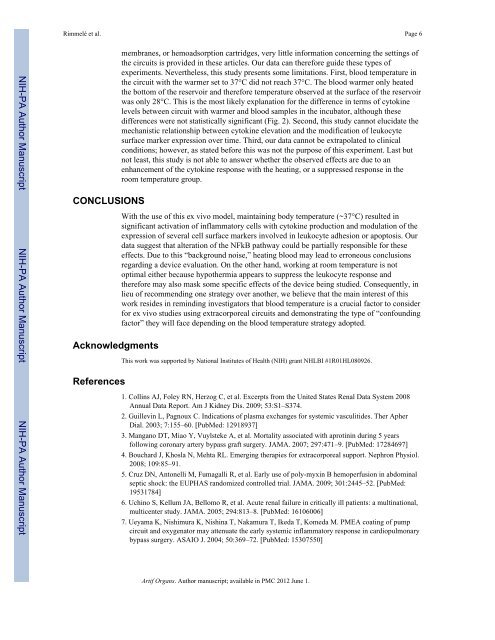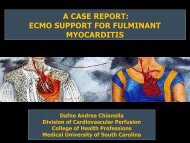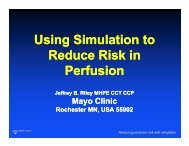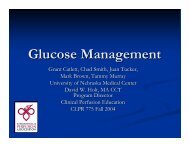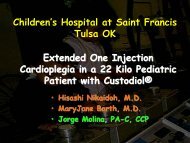Read the Full Text (PDF) - Perfusion.com
Read the Full Text (PDF) - Perfusion.com
Read the Full Text (PDF) - Perfusion.com
Create successful ePaper yourself
Turn your PDF publications into a flip-book with our unique Google optimized e-Paper software.
Rimmelé et al. Page 6<br />
NIH-PA Author Manuscript NIH-PA Author Manuscript NIH-PA Author Manuscript<br />
CONCLUSIONS<br />
Acknowledgments<br />
References<br />
membranes, or hemoadsorption cartridges, very little information concerning <strong>the</strong> settings of<br />
<strong>the</strong> circuits is provided in <strong>the</strong>se articles. Our data can <strong>the</strong>refore guide <strong>the</strong>se types of<br />
experiments. Never<strong>the</strong>less, this study presents some limitations. First, blood temperature in<br />
<strong>the</strong> circuit with <strong>the</strong> warmer set to 37°C did not reach 37°C. The blood warmer only heated<br />
<strong>the</strong> bottom of <strong>the</strong> reservoir and <strong>the</strong>refore temperature observed at <strong>the</strong> surface of <strong>the</strong> reservoir<br />
was only 28°C. This is <strong>the</strong> most likely explanation for <strong>the</strong> difference in terms of cytokine<br />
levels between circuit with warmer and blood samples in <strong>the</strong> incubator, although <strong>the</strong>se<br />
differences were not statistically significant (Fig. 2). Second, this study cannot elucidate <strong>the</strong><br />
mechanistic relationship between cytokine elevation and <strong>the</strong> modification of leukocyte<br />
surface marker expression over time. Third, our data cannot be extrapolated to clinical<br />
conditions; however, as stated before this was not <strong>the</strong> purpose of this experiment. Last but<br />
not least, this study is not able to answer whe<strong>the</strong>r <strong>the</strong> observed effects are due to an<br />
enhancement of <strong>the</strong> cytokine response with <strong>the</strong> heating, or a suppressed response in <strong>the</strong><br />
room temperature group.<br />
With <strong>the</strong> use of this ex vivo model, maintaining body temperature (~37°C) resulted in<br />
significant activation of inflammatory cells with cytokine production and modulation of <strong>the</strong><br />
expression of several cell surface markers involved in leukocyte adhesion or apoptosis. Our<br />
data suggest that alteration of <strong>the</strong> NFkB pathway could be partially responsible for <strong>the</strong>se<br />
effects. Due to this “background noise,” heating blood may lead to erroneous conclusions<br />
regarding a device evaluation. On <strong>the</strong> o<strong>the</strong>r hand, working at room temperature is not<br />
optimal ei<strong>the</strong>r because hypo<strong>the</strong>rmia appears to suppress <strong>the</strong> leukocyte response and<br />
<strong>the</strong>refore may also mask some specific effects of <strong>the</strong> device being studied. Consequently, in<br />
lieu of re<strong>com</strong>mending one strategy over ano<strong>the</strong>r, we believe that <strong>the</strong> main interest of this<br />
work resides in reminding investigators that blood temperature is a crucial factor to consider<br />
for ex vivo studies using extracorporeal circuits and demonstrating <strong>the</strong> type of “confounding<br />
factor” <strong>the</strong>y will face depending on <strong>the</strong> blood temperature strategy adopted.<br />
This work was supported by National Institutes of Health (NIH) grant NHLBI #1R01HL080926.<br />
1. Collins AJ, Foley RN, Herzog C, et al. Excerpts from <strong>the</strong> United States Renal Data System 2008<br />
Annual Data Report. Am J Kidney Dis. 2009; 53:S1–S374.<br />
2. Guillevin L, Pagnoux C. Indications of plasma exchanges for systemic vasculitides. Ther Apher<br />
Dial. 2003; 7:155–60. [PubMed: 12918937]<br />
3. Mangano DT, Miao Y, Vuylsteke A, et al. Mortality associated with aprotinin during 5 years<br />
following coronary artery bypass graft surgery. JAMA. 2007; 297:471–9. [PubMed: 17284697]<br />
4. Bouchard J, Khosla N, Mehta RL. Emerging <strong>the</strong>rapies for extracorporeal support. Nephron Physiol.<br />
2008; 109:85–91.<br />
5. Cruz DN, Antonelli M, Fumagalli R, et al. Early use of poly-myxin B hemoperfusion in abdominal<br />
septic shock: <strong>the</strong> EUPHAS randomized controlled trial. JAMA. 2009; 301:2445–52. [PubMed:<br />
19531784]<br />
6. Uchino S, Kellum JA, Bellomo R, et al. Acute renal failure in critically ill patients: a multinational,<br />
multicenter study. JAMA. 2005; 294:813–8. [PubMed: 16106006]<br />
7. Ueyama K, Nishimura K, Nishina T, Nakamura T, Ikeda T, Komeda M. PMEA coating of pump<br />
circuit and oxygenator may attenuate <strong>the</strong> early systemic inflammatory response in cardiopulmonary<br />
bypass surgery. ASAIO J. 2004; 50:369–72. [PubMed: 15307550]<br />
Artif Organs. Author manuscript; available in PMC 2012 June 1.


